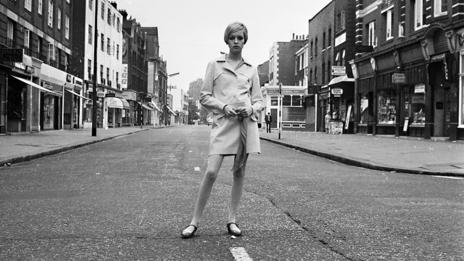
Natalie Wood (Globe Photos/Rex)
The shortened garment emerged in the 1960s as a symbol of rebellious
youth culture – and endures to this day. Katya Foreman looks back at the
style icon.
Among the many revolutions of the Swinging ’60s, from The Beatles to
the first man on the moon, the miniskirt remains one of the era’s most
enduring icons. While opinions differ on who invented the abbreviated
garment, with Mary Quant, André Courrèges, John Bates and Jean Varon
among the contenders, in London − the miniskirt’s launch pad − it was
local designer Quant who was the driving force behind the city’s ‘60s
fashions. In recognition of her legacy, a minidress by Quant − the
‘Banana Split’ – figured among 10 Design Classics stamps issued by the
Royal Mail in 2009 to celebrate a century of British design. The
selection included the Spitfire, the Concorde, the red telephone box and
the London Underground map.

Rising star
A heady mix of messages, Quant’s coquettish miniskirts telegraphed a tongue-in-cheek girly innocence and playful attitude, all the while packing a rebellious punch to the repressed post-war generation of the ‘50s raised on no-frills utilitarian designs. With its audaciously brief hemline, the miniskirt − then worn with flat Mary Janes, zip-up knee-high boots and thick, brightly coloured tights − challenged society and shook up conservative values. “Middle age business men would beat on the window and shout ‘It’s obscene, it’s disgusting.’ Extraordinary, isn’t it!” marvelled Quant in an interview with British Vogue’s Alexandra Shulman. Among its detractors, Coco Chanel dismissed the miniskirt as “just awful”.
“You’d had an increasingly conservative attitude from the 1930s through much of the 1950s, and the youth culture of the 1960s broke dramatically with that − although it had its roots in ‘50s youth culture, the beginning of the rise of rock ‘n’ roll and the idea of delinquence, and co-ed college girl style, but it really began to flourish in the 1960s,” observes Valerie Steele.

Staying true to the Hemline Index, whereby skirt hemlines rise along with stock prices, the miniskirt perfectly captured the zing of booming 1960s London. And, surfing the slipstream of The Beatles and The Rolling Stones’ global mania, demand for shorter hemlines soon took off (cementing the trend, Jackie Kennedy opted for a short white pleated Valentino dress for her marriage to Aristotle Onassis in 1968). Though the miniskirt’s popularity was soon overshadowed by the new hippie silhouette of long bell-bottoms and flowing skirts, the garment – today a wardrobe staple – has clung on, resurfacing with gusto during the 1980s (think rah-rah skirts and short skirted power suits).

Gathering multiple personalities across the years, with tweaks on length, material and accessories projecting radically different vibes, the miniskirt − arguably more than any other item of clothing − remains a symbol of youth. With women stretching its society-imposed age limits over time, especially in these celebrity-led body beautiful times, a whole heap of judgement has been piled on the age appropriate-ness of the miniskirt. According to a recent study by the British department store Debenhams, women today are happy to wear miniskirts up to the age of 40, whereas figures from 1980 showed that on average women stopped buying minis when they reached 33 years old. “If this trend continues, there's no doubt that, within the next decade, women in their mid 40s and early 50s will rightly regard a miniskirt as an essential part of their everyday wardrobe,” Debenhams said in the report.
Such a democratic view remains extremely short-sighted, however. With bans enforced in several African countries, the miniskirt didn’t even get a look in in certain territories. As recently as 2010, the mayor of an Italian resort town, Castellammare di Stabia, issued orders to police to fine anyone spotted wearing a 'very short' miniskirt, according to a report in the Guardian, while in late February around 200 women took to the streets of Uganda's capital to protest against a new anti-pornography legislation − dubbed ‘the miniskirt law’ by local media – which bans women from revealing their thighs, breasts and buttocks and from dressing indecently in a manner to sexually excite.
Fifty years after its invention, the garment still has many barriers to break.“With the rise of all kinds of religious fundamentalism in the world today there’s been a backlash against women and against sexual liberation, especially in terms of gay liberation ... On the one hand, we’ve become much more accepting of diversity in Western countries, however internationally things have turned very much to the right and we are seeing many cultures that are striking out at women for dressing in a way that is not hyper conservative and body concealing,” says Steele. While the miniskirt’s shock factor is a thing of the past in most Western cities, as well as cities like Tokyo or Shanghai in the East, “in much of the world, I would definitely hesitate to wear a miniskirt,” she added. “You’re looking forward to a much freer future and backwards to a much more restricted past, and the miniskirt is kind of symbolic of that.”






0 comments:
Post a Comment
Comment